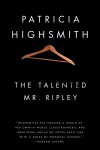‘In Dickie’s eyes Tom saw nothing more now than he would have seen if he had looked at the hard, bloodless surface of a mirror.’
 Patricia Highsmith is one of those writers so widely lauded that I felt embarrassed admitting I’d not read any of her books. Until now, the closest I got was on film – whether the Hitchcock version of Strangers on a Train (script by Raymond Chandler), which Highsmith apparently hated; or the 1999 adaptation of The Talented Mr Ripley, which she didn’t live to see made. I watched it years ago, half-enjoying it; but it seemed a little weak, and missing the dark edge that I’d believed Highsmith’s novels contained. I made a start on the book at the weekend, and initially I felt that it too was a slow (albeit compelling) burner. I didn’t properly fall for The Talented Mr. Ripley until about a third of the way through – page 78, to be precise. But we’ll get to that in a minute.
Patricia Highsmith is one of those writers so widely lauded that I felt embarrassed admitting I’d not read any of her books. Until now, the closest I got was on film – whether the Hitchcock version of Strangers on a Train (script by Raymond Chandler), which Highsmith apparently hated; or the 1999 adaptation of The Talented Mr Ripley, which she didn’t live to see made. I watched it years ago, half-enjoying it; but it seemed a little weak, and missing the dark edge that I’d believed Highsmith’s novels contained. I made a start on the book at the weekend, and initially I felt that it too was a slow (albeit compelling) burner. I didn’t properly fall for The Talented Mr. Ripley until about a third of the way through – page 78, to be precise. But we’ll get to that in a minute.
The Talented Mr Ripley sees the eponymous young protagonist sent to Europe by the father of acquaintance Dickie Greenleaf. Tom Ripley’s mission is to try and persuade Dickie to return to America, and take over the family firm. Dickie meanwhile has dreams of becoming a painter, and has bought a house in southern Italy; he lives there alongside the only other American in the village, a young woman named Marge Sherwood. With little to hold him in New York, Ripley enthusiastically takes up the opportunity to go after Dickie; and when he arrives he is rapidly seduced by Dickie’s rich and carefree lifestyle, becoming increasingly reluctant to give it up.
Now back to page 78. After the earlier, careful build-up of the story, it contained a passage that made me go suddenly and slightly cold. I looked to see if I had left the landing window open. There was also a lurch, like the one you get on a rollercoaster as it begins its descent, and you see the twisting, writhing track laid out in front of you. Like that track, the folds and knots in Tom Ripley’s character suddenly become more apparent; creepy up until this point, Ripley suddenly turns into an altogether more dangerous animal:
‘[Ripley] stared at Dickie’s blue eyes that were still frowning, the sun bleached eyebrows white and the eyes themselves shining and empty, nothing but little pieces of blue jelly with a black dot in them, meaningless, without relation to him. You were supposed to see the soul through the eyes, to see love through the eyes, the one place you could look at another human being and see what really went on inside, and in Dickie’s eyes Tom saw nothing more now than he would have seen if he had looked at the hard, bloodless surface of a mirror. Tom felt a painful wrench in his breast, and he covered his face with his hands. It was as if Dickie had been suddenly snatched away from him. They were not friends. They didn’t know each other. It struck Tom like a horrible truth, true for all time, true for the people he had known in the past and for those he would know in the future: each had stood and would stand before him, and he would know time and time again that he would never know them, and the worst was that there would always be the illusion, for a time, that he did know them, and that he and they were completely in harmony and alike. For an instant the wordless shock of his realisation seemed more than he could bear.’
Having come to know Ripley over the first third of the novel, we know there is something… not quite right about him. Something different. But this passage makes explicit Ripley’s separation from the world, as if he is viewing it through glass. Not only that, this passage also marks the point at which Ripley himself recognises the extent of this isolation, and the implications that it has. In doing so, it is as if Ripley makes a silent vow to himself, hidden even from the reader, the consequences of which are played out through the rest of the novel.
Even now, I find it impossible not to enjoy and admire that line about ‘the hard, bloodless surface of a mirror‘, the hinge on which this whole passage swings. It reverberates with unexpected echoes of murder – since when did mirrors have anything to do with blood? – but there’s also that idea of a reflection. The Talented Mr Ripley is a novel very interested in impersonations, and ‘other selves’ – and perhaps, in seeing Dickie in this way, Ripley is also viewing himself in a new light, realising what he is capable of. Up until this point, Ripley has seen himself as complementary to Dickie, his other half. Here, there is the suggestion that any such identification is futile, or at best illusory and temporary. Ripley now understands that he must act to take his own place in the world, pushing to one side thoughts of any consequences for those around him.
 Ripley’s initial yearning to be like Dickie – to become him – is made clear in another key scene, just before the section quoted above. Alone in their house, Ripley helps himself to the contents of Dickie’s wardrobe, dressing in his clothes and adjusting his hair to look more like him. ‘It surprised him how much he looked like Dickie with the top part of his head covered. Really it was only his darker hair that was very different from Dickie’ – two lines which hint at darker acts to come. Dickie inevitably catches Ripley in the act, placing further strain on their relationship, and reinforcing the isolation that Ripley feels and now believes he must act against.
Ripley’s initial yearning to be like Dickie – to become him – is made clear in another key scene, just before the section quoted above. Alone in their house, Ripley helps himself to the contents of Dickie’s wardrobe, dressing in his clothes and adjusting his hair to look more like him. ‘It surprised him how much he looked like Dickie with the top part of his head covered. Really it was only his darker hair that was very different from Dickie’ – two lines which hint at darker acts to come. Dickie inevitably catches Ripley in the act, placing further strain on their relationship, and reinforcing the isolation that Ripley feels and now believes he must act against.
It is this distance from the people around him that both drives and allows Ripley to act in the way that he does. This is also what makes him such a compelling protagonist – not bound by the ties of conventional morality, Ripley can operate entirely to his own self-interest. As the reader, we can only watch in disbelief and horror, and – let us not deny it – some envy, as these actions furnish Ripley with the lifestyle he craves. The Talented Mr. Ripley is one of those rare books that stays with you when you’re not reading it, willing you to reach the last page. Whilst we might not agree with the way Ripley behaves, we can at least understand it; and in understanding move closer to him, even if Ripley himself prefers to keep the rest of humanity at a safe distance.

I haven’t read the books but you have me drawn in here.
I hope so – I really enjoyed this one, and will be returning to the series before too long. Also interested in reading Highsmith’s non-Ripley books, and finding out more about her as a writer
Lovely review, this was pretty thrilling in itself! You have made me want to read it.
Exactly what I was trying to do, glad you enjoyed it! Thanks for the kudos Estelle, means a lot
An excellent piece. Like yourself,I’ve (embarrassingly) not read any Highsmith aside, in my case, from the novel of hers I abandoned when I was in my early to mid-teens. I do, however, have her The Cry of the Owl on my nightstand right now, having resolved I should do something about the omission. Your review has stiffened that resolve!
Good! A great writer, I’m looking forward to getting to grips with more of her work
Really good take on one of my favourite writers and one of her best books.
Thanks Paul – I really enjoyed reading it, looking forward to more.